- Camassia
-
Camassia
Camassia

Camassia cusickii Classification classique Règne Plantae Classe Liliopsida Ordre Liliales Famille Hyacinthaceae Genre Camassia
Lindl., 1832Classification phylogénétique Ordre Asparagales Famille Agavaceae Parcourez la biologie sur Wikipédia :
Camassia est un genre de 6 espèces de plantes herbacées à bulbe, originaires principalement de l'Ouest de l'Amérique du nord du Sud de la Colombie Britannique au Nord de la Californie. A l'Est, il atteint l'Utah, le Wyoming et le Montana. Anciennement placé dans les Liliaceae ou dans les Hyacinthaceae, les études génétiques et biochimiques permettent d'assigner ce genre à la famille des Agavaceae.Les différentes espèces sont appelées Camas, Quamash, Indian hyacinth, ou Wild hyacinth aux États-Unis.
Liste des espèces
- Camassia angusta
- Camassia cusickii S.Watson, 1888.
- Camassia howellii S.Watson, 1890.
- Camassia leichtlinii S.Watson, 1885.
- Camassia quamash (Pursh) Greene, 1894 - quamash
- Camassia scilloides (Raf.) Cory, 1936
Culture et utilisation
- Usage ornemental
C'est une plante à bulbe de culture facile au jardin. Elles demande un sol riche en humus.
- Usage alimentaire
Les bulbes de quamash faisaient partie de l'alimentation traditionnelle des tribus indiennes. Consommés grillés ou bouillies, leur goût ressemble à celui de la patate douce. Ces bulbes ont même contribué à la survie des membres de l'expédition de Lewis et Clark (1804-1806).
Bien que les immenses étendues de prairies à camas aient été réduites par le développement de l'agriculture moderne, il reste de nombreuses zones de prairies et de marais à camas dans l'Ouest américain.
Avertissement: L'espèce à fleurs blanches, Zigadenus venenosus, dont les bulbes peuvent être confondus avec ceux, comestibles, des espèces du genre Camassia est toxique .
Références
- Brisland, Richard T. W. Camas processing or upland hunting : an interpretation of lithic scatters at High Prairie. Calgary, Alb.: University of Calgary, 1992. Thesis (M.A.)
- Comber, Harold F.; Miller, Murray. Check list of the plants of the Camassia Natural Area : vascular plants. [Oregon]: Oregon Chapter, The Nature Conservancy, 1967
- Coville, Frederick V. (1897). The technical name of the camas plant. Proceedings of the Biological Society of Washington 11: 61-65.
- Gould, Frank W. A systematic treatment of the genus Camassia Lindl. Notre Dame, Ind.: University Press, 1942.
- Konlande, J. E.; Robson, John R. (1972). The nutritive value of cooked camas as consumed by Flathead Indians. Ecology of food and nutrition 2: 193-195.
- Maclay, Anne M. Studies of the life history of Camassia quamash (Pursh) Greene. Pullman, Wash., State College of Washington (Washington State University), 1928. Thesis (M.S.)
- Rice, Peter M.; Toney, J. Chris.; Cross, Marcia Pablo. Rehabilitation of camas and bitterroot gathering sites: study plan. [Hamilton, Mont: Bitterroot National Forest: U.S. Forest Service], 1996.
- Smith, Harriet L. Camas: the plant that caused wars. Lake Oswego, Or.: Smith, Smith and Smith Pub. Co., 1978.
- Stevens, Michelle L. and Darris, Dale C. Plant Guide for Common Camas: Ethnobotany, Culture, Management, and Use. Plant Materials Technical Note No. 25. (June 16, 2000) U.S. Department of Agriculture Natural Resources Conservation Service, Portland, Oregon, 2000.
- Stevens, Michelle L. and Darris, Dale C. Ethnobotany, Culture and Use of Great Camas (Camassia quamash ssp. quamash). Plant Materials Technical Note No. 23 (September 1999). U.S. Department of Agriculture Natural Resources Conservation Service, Portland, Oregon, 1999
- Storm, Linda. Patterns and Processes of Indigenous Burning 2000
- Statham, Dawn Stram. Camas and the Northern Shoshoni: a biogeographic and socioeconomic analysis. Boise, Idaho: Boise State University, 1982.
- Thoms, Alston V. The northern roots of hunter-gatherer intensification: camas and the Pacific Northwest. Pullman, Wash.: Thesis (Ph. D.)--Washington State University, 1989.
- Toney, J. Chris. Traditional plant restoration: restoration of camas & bitterroot gathering sites (phase I-year 1 progress report). [Hamilton, Mont: Bitterroot National Forest: U.S. Forest Service], 1997
- Portail de la botanique
Catégories : Agavaceae | Liliales | Flore (nom scientifique)
Wikimedia Foundation. 2010.
